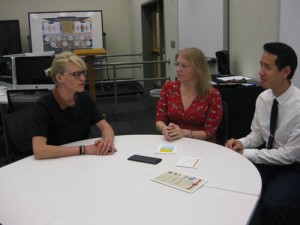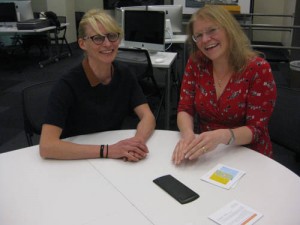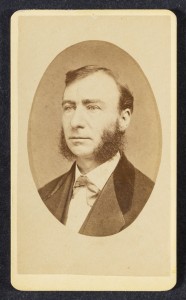By: Emma Wilson, English and Alabama Digital Humanities Center Postdoctoral Fellow & Christa Vogelius, CLIR Postdoctoral Fellow

Christa Vogelius receives a digital humanities consultation from Emma Wilson and Muzel Chen at the Alabama Digital Humanities Center (ADHC)
The Alabama Digital Humanities Center (ADHC) at the University of Alabama, located in Gorgas Library Room 109, provides support for innovative digital research and pedagogy within the university community. The mission of the ADHC overlaps in interesting ways with a central goal of the Division of Special Collections: to increase access to archival materials. At the ADHC, faculty and graduate students can meet with Postdoctoral Fellow Emma Annette Wilson and Technology Specialist Muzel Chen to discuss their ideas for digital research and pedagogy, including projects such as scholarly websites or digital exhibits; textual analysis; data visualization through maps, charts, or diagrams; and incorporating the digital humanities into their teaching. Some of these projects depend closely on the digitization of archival materials, and this blog post records an initial consultation at the ADHC between CLIR Postdoctoral Fellow Christa Vogelius from the Division of Special Collection’s A.S. Williams III Americana Collection and Emma Wilson. It showcases both the kind of support the ADHC provides for digital projects, and the ways that the University of Alabama’s archival community benefits from this resource.
Emma Wilson: Christa, first, thanks for coming in. Perhaps you could tell me a bit more about the collection that you’re working with at the moment and the kind of digital project that you foresee?

Christa Vogelius and Emma Wilson collaborate on using Williams Collection materials in digital humanities projects with help from the ADHC
Christa Vogelius: At the Williams Collection now, we’re working with digital services to digitize a collection of 21 binders of carte de visite portrait photographs from Southern photography studios. Cartes de visite were small, inexpensive photographs mounted on cardstock that was typically only about 2 1/2 by 4 inches—about the size of a visiting or business card. They were extremely popular in the second half of the nineteenth century, and cheap enough that most people could afford to have many portraits taken in the course of their lifetimes. The images in this collection are interesting because of the number of Southern portrait studios that are represented. We want to be able to show visually the geographic range of the studios represented, and so once digital services finishes photographing the images, and I finish the metadata with the studio information for each photograph, we hope to create a map showing the collection’s studio locations.
EW: That sounds fascinating. Do you know who the sitters in the photographs are at all?

T.T. Sourtwick, Godfrey and Noble’s Sunbeam Gallery, from the Southern Cartes de Visite album of the A.S. Williams III Collection
CV: In some cases, the names of sitters and other background information like the date of the sitting is handwritten on the back of the cards. I’m recording that information as part of the metadata for the collection, so that once all of the collection is up on Acumen, users will be able to search for names and dates to get the images that they’re looking for. But most of the sitters aren’t identified—the most common information we have for the pictures is the studio name and location, which most of the studio owners had printed on the back.
EW: What work has been done to date to get the cartes digitized? What kind of planning did you need to do for that, and what factors did you have to take into consideration when making these plans?
CV: Right now, digital services is working on digitizing the last batch of six binders of CDVs. As they’re digitizing, they’re also making the first round of metadata: assigning an item number to each image and entering information, if any is known, on the city or state of each image. The first several binders of photographs are already up on Acumen and are searchable by this information and the name of the collection, Southern Cartes de Visite Collection. I’m working on recording the more detailed metadata for these images, such as the writing on the back and specific street addresses of studios, so at some point all of this information will be searchable through Acumen.
EW: And once all the digitized cartes are available to view in Acumen, what else are you hoping to do with the collection?
CV: Since the most reliable information we have on the images is studio location, and since we are recording all of this information in any case, a visual mapping of the locations across the South, along with the number of images represented from specific studios, is the major goal. I hope that we can create something that will allow users to see at a glance where in the South the strengths of the collection are, and at the same time provide some more detailed information in pop-up bubbles about the studios. I also think it would be great to have a little bit of written context, and possibly a place to showcase some standout images.
EW: So for the map, you would want some flexibility, and some way of distinguishing between the cartes with very specific street addresses, and those which denote only county or state?
CV: Ideally, yes. Since we have roughly equal numbers of studios that we can locate at a very specific street address and studios identified only by their city or state, it seems important to represent both groups, but to show—maybe through a different color pinpoint—the level of accuracy for the location. It would also be great if we can show visually—maybe through the size of the pinpoint—which studio have the largest number of images in the collection.
EW: Okay. Let’s start thinking about the potential contents for your digital exhibit.
CV: I was thinking that it would include a brief intro to the carte de visite format with some context on the form in the South specifically. Then it would also be great to give a little more detail on the strengths of the collection, profiling some of the locations or photographers that are well-represented, as well as showing some common themes in the portraits.
EW: This is great information from our first meeting. Now, our technology specialist, Muzel, and I will meet to explore some of the potential technological approaches for this project. We’ll look at a range of different software and website construction tools, work out a few different options, and then all three of us should convene next week to discuss which of these we think will best meet the needs of this project.

